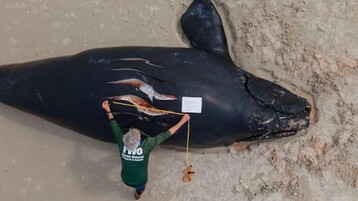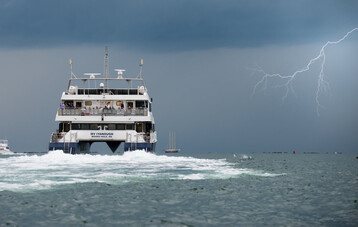Ferries, Fishermen Alarmed By Proposed Right Whale Speed Restrictions
Jason Graziadei •

Nantucket’s ferry operators and fishermen are sharing dire warnings about proposed seasonal speed restrictions for vessels along the East Coast - including all of Nantucket Sound - that are under consideration by the National Oceanic and Atmospheric Administration (NOAA) to protect critically endangered right whales.
The “proposed North Atlantic right whale seasonal speed zones” would apply to most vessels over 35-feet long from Nov. 1 through May 30, restricting their speed to no more than 10 knots (about 11.5 mph). As it's written, the new rule would apply to all Hy-Line Cruises and Steamship Authority vessels, and effectively eliminate high-speed ferries during those months.
“It’s crazy,” said Murray Scudder, president of Hy-Line Cruises. “It would shut down commerce to both islands. We would be out of business. It’s frustrating because you’re talking about people who don’t have any clue about what the impacts are. The economic impacts they’re listing are $40 million. It’s closer to $40 billion. You can’t imagine it happening, but as it’s written, that’s what would happen.”
Charter boat captain and former Nantucket Select Board member Bob DeCosta did not mince words in sharing his reaction to the idea of restricting vessels to 10 knots for six months of the year.
“This is the scariest goddamn thing I’ve ever seen,” DeCosta said. “This is a perfect example of what paid lobbyists can do with politicians being the paid whores they are. I’ve been on the water for 50 years and I’ve never seen a right whale in Nantucket Sound.”

DeCosta said that beyond the ferries, the proposed speed restrictions would impact private boats, along with charter vessels that start earlier in the year, or someone delivering a boat down south.
“It’s ridiculous,” he said. “This is what’s wrong with our government today.”
The proposed rules have been put forward by NOAA Fisheries to reduce the risk of lethal vessel collisions with endangered North Atlantic right whales. Current estimates peg the North Atlantic right whale population at less than 350 individuals remaining, and scientists believe they are highly susceptible to vessel strikes given their distribution and frequency at near-surface depths, especially for mother and calf pairs.
“Collisions with vessels continue to impede North Atlantic right whale recovery,” said Janet Coit, Assistant Administrator for NOAA Fisheries. “This proposed action is necessary to stabilize the ongoing right whale population decline, in combination with other efforts to address right whale entanglement and vessel strikes in the U.S. and Canada.”

The proposal from NOAA would approximately double the area under speed restrictions along the East Coast, and the changes would disproportionately impact the Northeast/Mid-Atlantic area, whereNOAA believes substantial strike risk remains unaddressed.
There have been four lethal (death and serious injury) right whale vessel strike events in U.S. waters since 2020, according to NOAA.
“We have made progress in addressing the threat of vessel strikes, but additional action is warranted to further reduce the risk of lethal strike events to ensure the species can get back on track to recovery,” said Kim Damon-Randall, Director, Office of Protected Resources, NOAA Fisheries.
Rob Ranney, Nantucket’s representative on the Steamship Authority’s Board of Governors, said the boat line has not yet formulated a formal response, but he shares Scudder’s concerns about the impacts of the new speed zones as proposed.
“It would be devastating,” Ranney said. “Obviously it would affect ferry service if speeds are limited to 10 knots. If you dropped it down to 10 knots, you’re talking about boats not keeping their schedules, which would wreak havoc on our service, and forget about fast ferries. I don't know what would happen.”

The current mandatory 10-knot speed restrictions implement in specific areas/times off the East Coast apply only to vessels over 65 feet. The new rule would broaden the restrictions to include vessels over 35 feet, as well as expand the areas covered by those speed zones.
Certain vessel categories are exempt - including military, search and rescue, and enforcement - and there is a provision to allow vessels to exceed 10 knots during certain weather conditions that severely impact maneuverability.
NOAA estimates 15,899 vessels would be impacted by the new proposed speed zones, and of those, 59 percent are recreational/pleasure, 22 percent are ocean-going ships, while the other 19% are commercial, industrial, or “other.”
Those were the numbers Carl Bois, captain of the Topspin charter boat, was thinking about as he reviewed the proposed speed zones.
“Trying to get offshore under such conditions would leave no time for any actual fishing,” Bois said. “This has the potential to affect commercial, recreational, and transportation along the water. This is crossing some boundaries that will hurt many facets of coastal communities. This is extremely concerning to me.”
The comment period in which citizens, businesses, organizations and governments can submit response to the proposed rules is now open. In response to numerous requests for an extension, the National Marine Fisheries Service recently announced an extension of the public comment period by an additional 30 calendar days ending on October 31, 2022.
Click here to submit a comment.